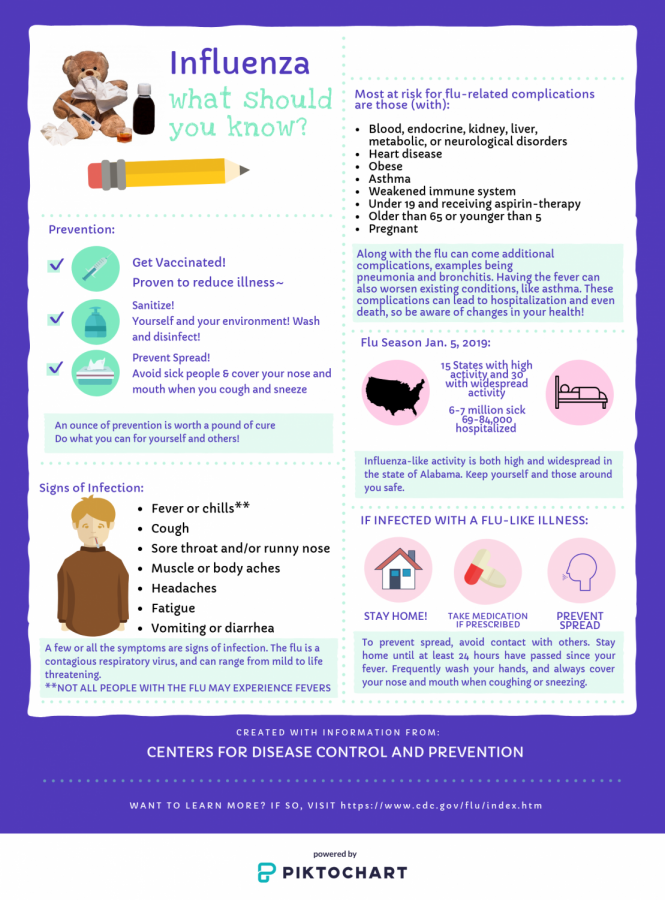Influenza Gone Viral
January 17, 2019
15 states, according to the Centers for Disease Control and Prevention (CDC), are considered to have “high influenza-like illness.” Not only does Alabama happen to be one of them, but this activity is expected to only increase. During last influenza season – January to September of 2018 – there were 60 reported flu-related deaths (33 being laboratory confirmed) across Northern and Northeastern Alabama out of the 145 across the entirety of the state.
With Alabama also being one of now 30 states experiencing widespread influenza, it is crucial that we take it upon ourselves to prevent further infection and spread to the best of our capabilities. As a local parent explained, “Preventing influenza is much easier than dealing with it.”
“It’s a virus,” stated Ellie Tsikalas, a certified registered nurse practitioner (CRNP) of Brightstarts Pediatrics. “It’s going to be contagious. You’re literally shedding the germs, and it can spread through droplets – close talking or coughing in the vicinity – and even from your spit somehow touching a surface. The germs can live there for a while.”
Influenza is a contagious respiratory virus, and it can range from mild to life-threatening. Its symptoms include a fever or chills, cough, sore throat, runny nose, muscle or body aches, headaches, fatigue, and vomiting/diarrhea (which are more common in children). It is important to note that not every case of influenza will involve a fever (CDC).
“It usually takes a few days for symptoms to set in. Let’s say you were around someone with the flu. Probably around 2-3 days is when your symptoms are going to show up. It is a virus though, so it will go away on its own and won’t need treatment. The only time it becomes a problem is if the mucus and stuff created by the flu then becomes something else, like pneumonia or a sinus infection,” Tsikalas added.
Most people who become ill with the flu will experience illness mild enough to not need medical attention or medication. In some, however, that is not the case. The flu can worsen existing complications or bring more issues along with it. It is not uncommon, for example, for those with asthma to experience asthma attacks while they are ill. Those more at risk for flu-related complications include those who are obese, pregnant, older than 65 or younger than five, younger than 19 and receiving long-term aspirin therapy, or those who have asthma, various disorders (blood, kidney, liver, neurological, endocrine, metabolic, etc.), or chronic lung or heart disease (CDC).
If you are worried about your symptoms or are one of those at a high risk to begin with, check with your healthcare provider. Otherwise, typically, the flu and its symptoms will resolve themselves without treatment should no other complications arise. It is essential that those sick receive plenty of rest and hydrate themselves well. They should also make sure to limit their contact with others to prevent further spread. It is recommended that the ill stay home until a minimum of 24 hours have passed since their fever (CDC).
This information was provided from the Centers for Disease Control and Prevention website. If you have additional questions regarding influenza or simply wish to find more information, go to www.cdc.gov/flu.



